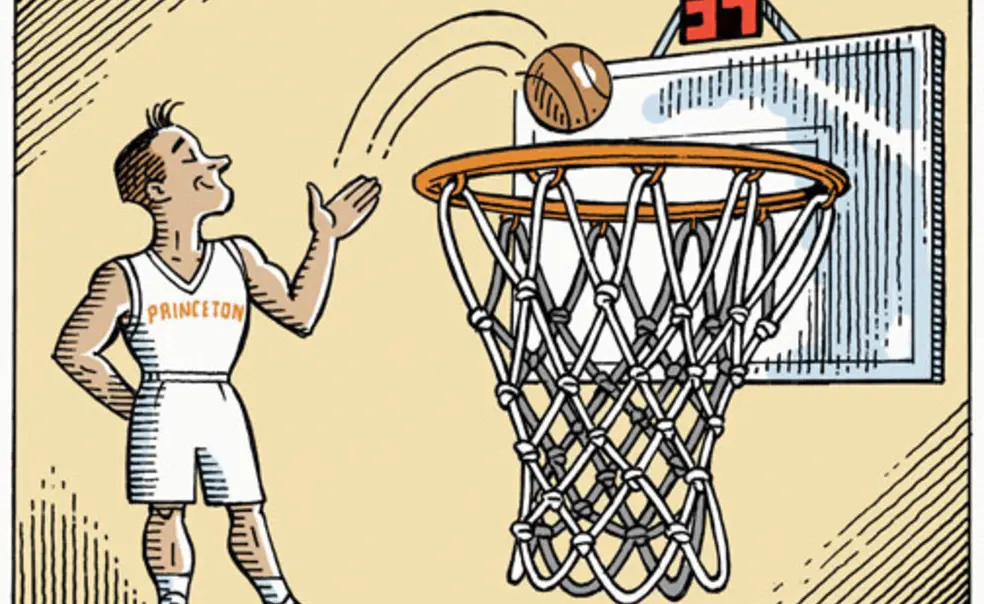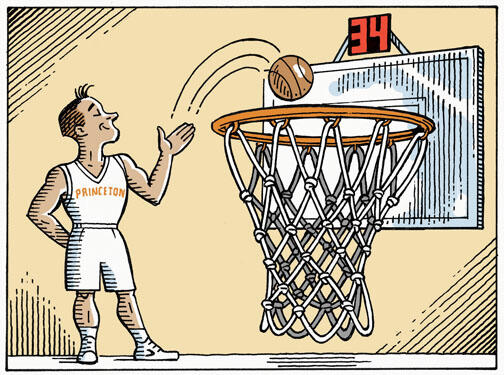EXTRA POINT: Revving up a revolutionary system in basketball
Legendary basketball coach Pete Carril’s most lasting innovation was the Princeton Offense. He cobbled it together from a variety of old basketball moves — the weave, the dribble handoff, and the pivot play popularized by the barnstorming Original Celtics of the 1920s. Instead of standing under the basket, the center was positioned beyond the free-throw line, becoming a kind of “point center” around whom his four teammates could move like hyperactive children circling a maypole. The players passed the ball around and around the perimeter and then ... passed it around some more. Endlessly, it sometimes seemed.
So deliberate and unhurried was Princeton that the scores of both teams dropped as the Tigers waited for the defense to make a mistake. When it worked, as it often did, even against more athletically gifted teams — who can forget Gabe Lewullis ’99’s backdoor layup to beat defending champion UCLA at the 1996 NCAAs? — it was beautiful: selfless, old-school basketball of the highest order.
The Princeton Offense was so admired that these days it has conquered every corner of the known basketball universe, from high school teams all the way to the NBA. The novelty is gone. Princeton’s opponents are no longer flummoxed by the Offense — they either use it or face teams that do.
So the celebrated Offense is undergoing a tweak. Last year’s Tigers — who won the Ivy League title and nearly upset Kentucky in the NCAA tournament — averaged 69.2 points per game, evidence of a faster, higher-scoring approach. That shift of gears is the legacy of former coach Sydney Johnson ’97, a change his successor and former teammate, Mitch Henderson ’98, is building on in his first year as head coach.
This is a welcome change for Princeton basketball. Tiger teams of the past, even the great ones, never seemed to have a Plan B. Rarely did they consider shooting in the first half of a possession. Then, with the shot clock dwindling to zero, they would take the shot they had passed up 20 seconds before, but with one key difference: The defense was now on high alert. And the Tigers were so deliberate that they seemed to have trouble shifting gears late in the game, even when they desperately needed to.
Princeton’s methodical play has given it a real chance against virtually any opponent. Taking an early shot when it’s there will make the methodical pace even more effective. Athletes as smart as Princeton’s surely can handle a second, faster pace.
This year’s team, led by Doug Davis ’12 and Ian Hummer ’13 (see page 27), looks quite capable of speeding things up, especially T.J. Bray ’14, an angular, 6-foot-5-inch guard who was voted the top high school player in Wisconsin. In the Tigers’ 67–59 loss to Cornell and 62–58 win over Columbia, Bray racked up a total of 24 points. He had eight rebounds and seven assists against Cornell and six steals against Columbia. A player that versatile should be the perfect fit for the most versatile offense the Tigers have used in years.
Extra Point explores the people and issues in Princeton sports.
Merrell Noden ’78 is a former staff writer at Sports Illustrated and a frequent PAW contributor.













No responses yet